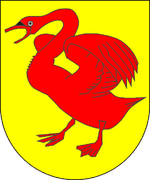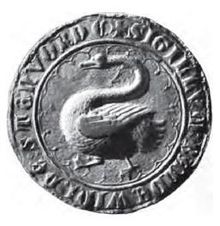Dominion Steinfurt
|
Territory in the Holy Roman Empire |
|
|---|---|
| Steinfurt County | |
| coat of arms | |

|
|
| map | |

|
|
| The county of Steinfurt in the Lower Rhine-Westphalian Empire 1560
|
|
| Consist | 1454-1806 |
| Form of rule | monarchy |
| Ruler / government | Count
|
| Reichskreis | Lower Rhine-Westphalian |
| Capitals / residences | Steinfurt |
| Dynasties | House Bentheim-Steinfurt |
| Denomination / Religions | ev.-reformed |
| Language / n |
German , Low German
|
| Incorporated into |
Berg (1806), France (1810), Prussia (1815)
|
The rule Steinfurt , from 1495 County Steinfurt , was a territory in the Holy Roman Empire in today's Münsterland with the focus on Steinfurt . It existed until 1806.
Beginnings
The Steinfurt rule emerged from a Steinfurt castle (Stenvorde), which was first mentioned in 1129 . Their noble owners called themselves Herren von Steinfurt. In 1164 there was a feud with the Lords of Ascheberg . Both castles were destroyed. With the support of Archbishop Rainald von Dassel , the people of Steinfurt rebuilt their castle. When the Aschebergers died out, their ownership passed to the noblemen of Steinfurt in 1206.
A lordship arose from the property, which mainly included the parish of Steinfurt. In addition, from 1270 came the bailiwick of the Borghorst dynasty , in 1279 the Gogericht Rüschau and in 1365 Gronau. The Steinfurters also had the bailiwick of the St. Mauritz and Überwasser monasteries in Münster .
There were also extensive possessions in Emsdetten , Mesum and Rheine . These were protected by a castle.
Confrontation with the Münster monastery
In this area there was a conflict with the Hochstift Münster . In 1343 the Münster troops destroyed the castle and the Steinfurters lost all of their property in this area. When Baldwin II of Steinfurt was enfeoffed with the Free County of Laer in 1357, this part of their territory was immediately part of the empire.
The ongoing opposition to Münster led to Ludolf von Steinfurt being captured by Bishop Otto IV in 1396 and only being released against the payment of a high ransom and the recognition of episcopal sovereignty over the rule of Steinfurt.
Association with Bentheim and imperial immediacy
The noblemen of Steinfurt died out in the 15th century. In 1421, rule fell to Everwin Götterwick through an heir. In the same year, this won the Grafschaft Bentheim . The areas of the Grafschaft Bentheim and the rule Steinfurt were separated again in 1454. Arnold I succeeded Everwin in Steinfurt. Through his marriage to Katharina von Gemen, the property of Wevelinghoven near Neuss fell to Steinfurt.
Because Steinfurt was oppressed by the bishops of Münster, the rule was assigned to the empire as a fief. The elevation to an imperial county was related to this. In addition, there were the merits of Everwin II in the wars of Maximilian I. Nevertheless, the office of Rüschau fell to the monastery of Münster in the 16th century.
The county had belonged to the Lower Rhine-Westphalian Imperial Circle and the Westphalian Imperial Counts' College since the 16th century .
In 1530 there was a temporary reunification of Bentheim and Steinfurt under Arnold II of Steinfurt. Under his rule, the Augsburg Confession was introduced in both territories from 1544 .
Territorial high and low
The territorial existence of the county was called into question by a process initiated by the bishopric of Münster in 1547 before the Reich Chamber of Commerce. Münster questioned the imperial immediacy of Steinfurt.
In Steinfurt Arnold III. Count. At that time, the conflict with Münster intensified. Arnold denied the ecclesiastical jurisdiction of the prince-bishops and had the Johanniter expelled.
Under Arnold IV , at whose time Steinfurt reached its greatest territorial expansion, the Reformed teaching was introduced in 1591 . After his death, the property was divided among his five sons. This led to long conflicts within the family. A settlement was only agreed in 1638. Arnold Jobst von Steinfurt received Steinfurt, a Tecklenburger line Wevelinghoven and Gronau. Another comparison led to the renewed separation of Steinfurt and Bentheim in 1665. Under Count Philipp Konrad, the Steinfurt position was so weakened that from 1660 the city of Steinfurt was occupied by Bishop Bernhard von Galen . This state lasted until 1720.
Under Count Ernst, who assumed rule in Steinfurt in 1691 after internal disputes within the family, indivisibility and the right of the firstborn were introduced in a house law. After his death, his widow signed a contract with the bishopric of Münster in 1716 because of the high occupation costs and the ongoing trial before the Imperial Court of Justice. Then the county lost part of its territory to the bishopric of Münster. Since then it has been essentially limited to the office and the parish of Burgsteinfurt.
In 1804 it was reunited with the Bentheim line. Only two years later it became part of the Grand Duchy of Berg , fell to France in 1811 and Prussia in 1815 .
See also
swell
- Joseph Niesert : Codex diplomaticus Steinfordiensis or collection of documents on the history of the Steinford rule. Department 1 Coesfeld, 1834 digitized
- Joseph Niesert: Codex diplomaticus Steinfordiensis or collection of documents on the history of the Steinford rule. Department 2 Coesfeld, 1835 digitized
literature
- Gerhard Köbler : Historical lexicon of the German countries. The German territories from the Middle Ages to the present. 7th, completely revised edition. CH Beck, Munich 2007, ISBN 978-3-406-54986-1 , p. 685 ( limited preview in the Google book search).
- Christof Spannhoff: Of facts and fictions: The origins of the noble lords of Steinfurt, in: Nordmünsterland. Forschungen und Funde 3 (2016), pp. 220–243.




